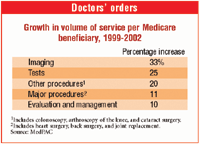Article
Where's the money?
Spending on physician services rose at a smart pace in 2003, but not across the board.
A single statistic from CMS may leave primary care doctors scratching their heads. Here it is: National expenditures on physician services rose 8.5 percent in 2003, according to a CMS report published in January in the journal Health Affairs.

Did you get an 8.5 percent raise in 2003? Chances are you didn't. Medical Economics' Continuing Survey showed that practice revenue for primary care physicians grew by only 3.4 percent in 2003, and their median compensation remained stuck at the 2002 mark of $150,000. The Medical Group Management Association looked at a different universe of doctors and turned up only slightly better results-internists, pediatricians, and FPs who don't deliver babies saw collections rise by 5.4 percent, and compensation by 2.4 percent.
But why the weak top line in 2003 for primary care doctors? That wasn't a problem for specialists, by and large. Their collections rose by 7 percent that year, and compensation by almost 8 percent, according to the MGMA. The Medical Economics Continuing Survey showed similar gains. For specialists, an 8.5 percent spending increase for physician services was pretty close to what they saw in their paychecks.
This economic disparity between primary care physicians and specialists is nothing new, despite the influence of RBRVS and other efforts to boost pay for cognitive services. "On a per-hour basis, specialists still make a lot more than primary care doctors," says Uwe Reinhardt, a healthcare economist at Princeton University. To Reinhardt, it boils down to the willingness of insurers to pay more for tests and procedures than the intellectual labor of evaluation and management, the forte of primary care.
At the same time, it's easier for specialists to increase their production in response to stingy third-party reimbursements by ordering more tests and procedures per visit. Primary care doctors are limited, ultimately, by the clock. They can see only so many patients each day. "There is a real ceiling on what primary care doctors can do or bill for," says Martey Dodoo, an economist at The Robert Graham Center, the Washington, DC-based healthcare think-tank founded by the American Academy of Family Physicians.
Statistics suggest that Dodoo is right about the ability of specialists to more quickly rev up their engines. The volume of E&M services per Medicare patient grew by 10 percent from 1999 to 2002, according to the Medicare Payment Advisory Commission, or MedPAC. In contrast, the volume of imaging services grew 33 percent, tests by 25 percent, and minor-to-middling procedures such as colonoscopy by 20 percent. Only major procedures, which include open-heart surgery, were a laggard, growing by 11 percent.
Such numbers lead to an unavoidable conclusion. "When doctors ask how they can grow their top line, the first answer I give is, 'Offer more ancillary services,' " says preventive medicine specialist and MGMA president and CEO William Jessee. However, achieving that goal is harder for primary care doctors, he notes. "They may not have enough money to implement ancillary services, or the volume to support them. In contrast, ancillaries tend to be direct adjuncts to what specialists normally do."





